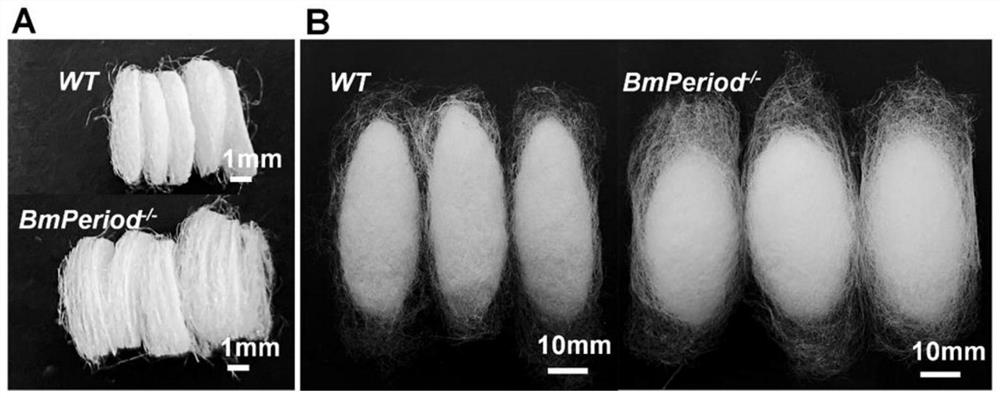Application of silkworm Period gene or protein in silkworm breeding and silkworm cocoon production
A silkworm and gene technology, applied in the field of sericulture, can solve problems such as tissue development without BmPeriod gene regulation
- Summary
- Abstract
- Description
- Claims
- Application Information
AI Technical Summary
Problems solved by technology
Method used
Image
Examples
Embodiment 1
[0034]The CRISPR / Cas9 knockout vector construction of embodiment 1 silkworm BmPeriod gene
[0035] (1) First of all, the present invention is aimed at the sequence of the BmPeriod gene, and through a large number of selections and tests, the CRISPRdirect website (http: / / crispr.dbcls.jp / ) is used to select 2 silkworms in the sixth exon of the BmPeriod gene BmPeriod gene-specific sgRNA recognition target (SEQ ID NO.3 and SEQ ID NO.4) and its full-length sequence (SEQ ID NO.5 and SEQ ID NO.6). The nucleotide sequence of the BmPeriod gene is shown in SEQ ID NO.1, and the amino acid sequence is shown in SEQ ID NO.2. Schematic diagram of silkworm BmPeriod gene structure and sgRNA target sequence figure 1 shown.
[0036] The sgRNA recognition target sequence is as follows:
[0037] sgRNA1: 5'-TCTCCAGCGCATGTACAGGT-3' (SEQ ID NO.3)
[0038] sgRNA2: 5'-CACTGAAGGCGACAAGGTAG-3' (SEQ ID NO.4)
[0039] The full-length sequence of sgRNA is as follows:
[0040] sgRNA1:
[0041] 5'-GACC...
Embodiment 2
[0061] Embodiment 2 Establishment of BmPeriod Gene Knockout Homozygous Line of Bombyx mori
[0062] (1) Bombyx mori egg preparation: The non-diapause eggs of silkworm Dazao were obtained by the conventional low-temperature and dark method of non-diapause egg production. Use plastic wrap as the egg attachment material, collect the eggs laid by the female moth within 30 minutes, soak in clean water for 20 minutes, and then gently wash off the silkworm eggs. Collect silkworm eggs quickly, arrange the plump and wet silkworm eggs neatly on the sterilized glass slide, absorb the water stains with filter paper, dry them for 20 minutes, put them in 3% formaldehyde water emulsion for 2 minutes, and sterilize them with water. After cleaning, let it dry for more than 20 minutes for microinjection.
[0063] (2) Introduction of the recombinant vector plasmid into silkworm eggs: the recombinant vector plasmid constructed in Example 1 was introduced into non-diapause silkworm eggs at the cl...
Embodiment 3
[0075] The silkworm BmPeriod gene mutant hybrid variety that embodiment 3 selection silk cotton production uses
[0076](1) According to the method of Example 1 and Example 2, the BmPeriod gene knockout mutant of silkworm was prepared, and the female moth homozygous for the BmPeriod gene knockout mutation was used as the female parent, and the dichroic practical hybrid combination Su with yellow cocoon The spring orange male moths of Yu × Chuncheng mated to obtain silkworm eggs of the H1 generation, and the larvae hatched from the H1 generation silkworm eggs were reared with a single moth breeding method. The low density and thick cocoon layer of the cocoon layer were used as indicators, and 10% of the moth area was preferred Mate with 10% of individuals with high cocoon silk content in the selected moth area to obtain H2 generation silkworm eggs;
[0077] (2) Raise the H2 generation larvae with a single moth breeding method, sample silkworm eggs from the embryonic development...
PUM
 Login to View More
Login to View More Abstract
Description
Claims
Application Information
 Login to View More
Login to View More - R&D
- Intellectual Property
- Life Sciences
- Materials
- Tech Scout
- Unparalleled Data Quality
- Higher Quality Content
- 60% Fewer Hallucinations
Browse by: Latest US Patents, China's latest patents, Technical Efficacy Thesaurus, Application Domain, Technology Topic, Popular Technical Reports.
© 2025 PatSnap. All rights reserved.Legal|Privacy policy|Modern Slavery Act Transparency Statement|Sitemap|About US| Contact US: help@patsnap.com



